Jan 26, 2024
A Guide to Capacity and Travel
You worked hard to buy the boat of your dreams. When you finally get the time to enjoy it, you don’t want to waste time getting it into the water. That is why so many waterfront owners choose to purchase boat lifts to store their vessel on site. Image the convenience of being in the water in minutes, while also keeping your boat safe and clean.
In order to achieve this, it’s important you choose the right boat lift to ensure the safety and longevity of your vessel. This guide will explore the key factors to consider when selecting a boat lift.
Understanding Capacity
Dry Weight vs. Operating Weight:
The first question you’ll need to answer when looking for a boat lift is, “What is the weight of your boat?” Your first thought will be to check your boats specifications, but there are many factors that contribute to your boats actual weight that are not listed in your boats specifications. The dry weight listed for boats often excludes outboard motors, fuel, fluids, gear, and accessories. You will need to consider the combined weight of these additional items when choosing lift capacity.
- Adding a 20% buffer to the total weight provides a safe margin for unforeseen variations.
- Overestimating capacity is wise if you plan to upgrade to a heavier boat in the future.
People and Cargo:
We know your time is limited and you want to spend as little time getting onto the water as possible. Storing your gear right on the boat is one of the biggest advantages of having your boat stored on site. You may not realize how much additional weight even the most typical items can add to your vessel. Now add a passenger or two. As you board your boat, you want to ensure easy access, especially for those who might not get around as easily anymore. To safely do this, you want to make sure you have taken these extra pounds into account.
- As per manufactures, boat lifts are not meant to carry people while in operation. Be sure to load and unload passengers with minimal time spent on the lift.
- As per manufactures, pontoon boats are not suitable as recreational decks while on the lift. With the proper increase in capacity, you could feel safer enjoying your boat even when it’s docked.
- Overloading the lift can cause serious injuries, and damage to both the boat and the lift itself.
Understanding Travel
The travel of a boat lift refers to the distance from its lowest position to its highest position. When the lift is in its highest position, you want to make sure the keel of your boat is high enough out of the water to avoid wave action. At its lowest position, you want to make sure you have enough water depth to freely float your boat off the lift.
Wave Action:
- Areas with strong waves necessitate a lift that elevates your boat sufficiently.
- Some lifts offer extended lifting ranges for optimal clearance in challenging conditions.
- Specific brands allow you to move small watercrafts away from the water entirely.
Water Depth:
- Knowing your water depth is crucial for selecting the appropriate lift type.
- Every body of water has daily and seasonal fluctuations, make sure you know the highs and the lows of your particular body of water.
- Shallow water may require a lift specifically designed for low water conditions.
- The lift’s minimum depth requirement needs to accommodate the draft of your boat.
Popular Boat Lift Options
Everyone’s needs are unique to their slice of paradise and the equipment they use. That’s why we have partnered with the industries top boat lift manufactures, so that we can provide a boat lift solution that fits your needs.

Offers cable and hydraulic lifts with capacities ranging from 1,200 lb to 12,500 lb.
Cable lifts have a 5’6” lifting range and require 12″ of water depth plus the boat’s draft.
Hydraulic lifts offer up to 5’ of lifting range and require 18″ of water depth plus the boat’s draft.

Offers hydraulic lifts with capacities ranging from 2,000 lb to 30,000 lb.
Hydraulic lifts have a maximum 6’6” of lifting range, ideal for areas with strong waves.
Lifts can be adapted for extremely low water levels with their shallow water kit.
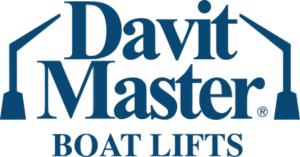
PWS offers Swinger lifts and Elevator lifts with capacities ranging from 1,500 lb to 16,000 lb.
Swinger lifts have a travel range of 8’6” and Elevator lifts have a customizable travel range.
Swinger lifts have the ability to rotate your craft 180° to move it away from the water completely.
Elevator lifts can operate at a 45° angle, making them ideal for overcoming obstacles.
Professional Assistance
PWS: Your Trusted Boat Lift Partner
Choosing the right boat lift can be complex, seeking professional assistance is recommended. PWS offers a comprehensive selection of ShoreMaster, SunStream and Davit Master boat lifts to meet your specific needs. Our experienced team can help you choose the right lift for your boat, water depth, and wave conditions.
Contact us today at (920) 493-4404 for a free consultation.
Additional Resources:
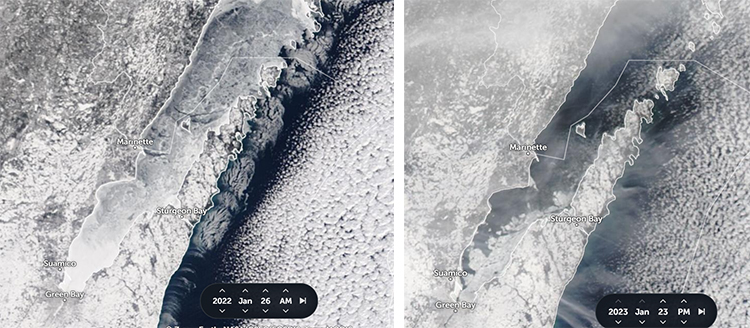
Mar 31, 2023
It may seem early in the season to be thinking about water levels but not for us! We need to know what to expect in the months to come to be ready for what may, or may not, happen. Summer water levels tell us how much pier our customers will need and where to install boat lifts. With extreme highs come shoreline damage, extra pipe for longer legs and big, damaging waves. With extreme lows, not enough pier to get adequate depth, higher demand for pier sections and extra work setting boat lifts. We’ve seen both of these issues within the past ten years. So what can you expect for this coming summer?
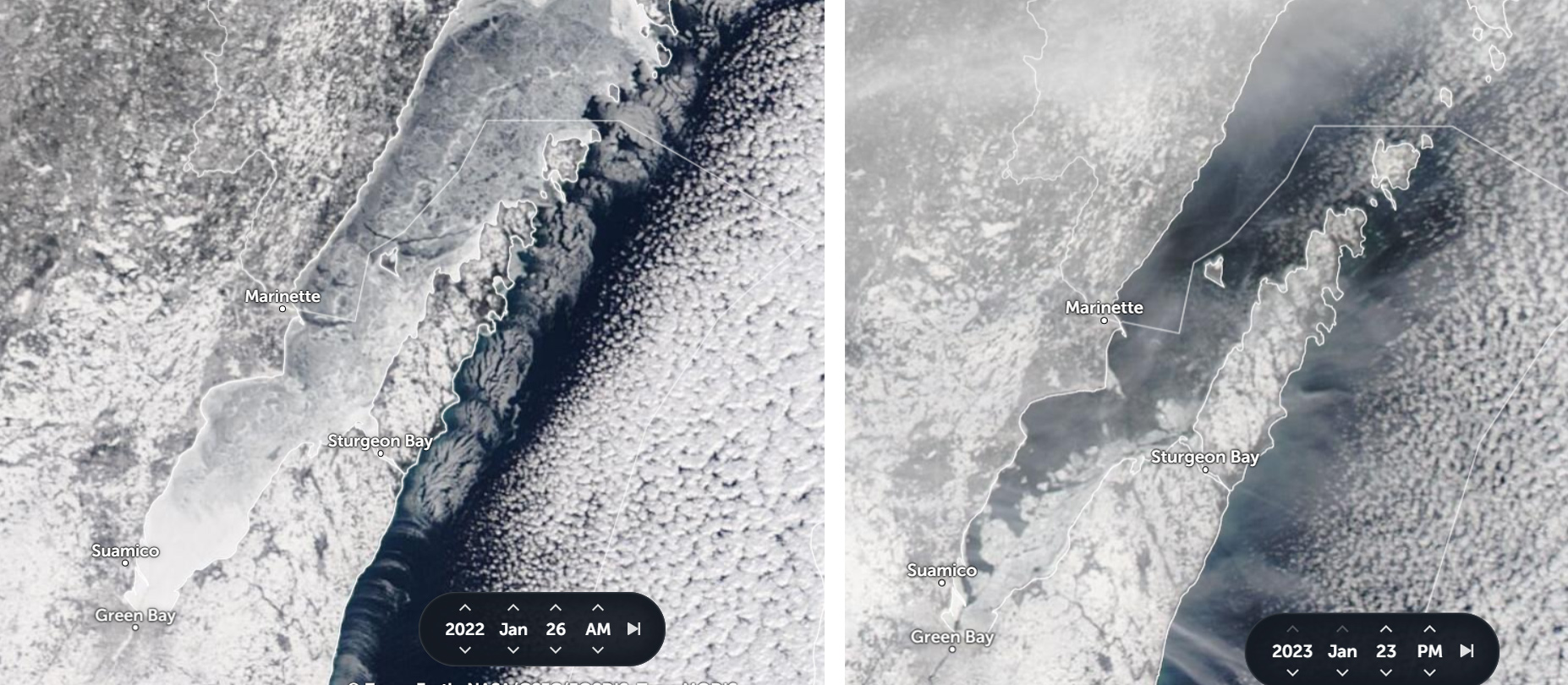
In order to know where our water levels will be this summer, you have to look at the condition of the lakes in the winter. Our current ice concentration on the Great Lakes remains below normal. If you look at the pictures in reference A, you will see the difference between the ice formation in late January 2022 and 2023.
So why is ice important you might ask? The amount of ice and snow formed over the winter directly affects the water levels in our lakes and streams come summertime. Without snow, we don’t have the snowpack melt needed to refill our aquifers in spring. On average, the melt from the snowpack is responsible for one third of the ground water we see in spring. Even though we may not have much snow in our specific area, we benefit greatly from the connection of the Great Lakes. Heavy snow fall in southern Canada melts and fills Lake Superior which in turn flows into Lake Huron which is hydraulically connected to Lake Michigan. The more snow the better too because the ratio of snow to water is only 12:1, meaning you need about 12” of snow to generate 1” of water. As snowmelt fills our lakes and streams, ice protects them from evaporation and outflow. Statistically we have lost 30% of ice coverage on the Great Lakes since 1970. Reduced ice cover leads to increased evaporation and lower water levels, as well as an increase in water temperature and sunlight penetration. This has caused lake ice to form later than usual, about a day to a day and a half per decade. The rising surface water temperature has also affected “ice off” or the thaw dates for ice on the Great Lakes. Earlier ice off dates, which is currently about 24 days sooner since studies began in the early 1900’s, means the lake absorbs more heat over spring and summer perpetuating the late ice formation. Another effect of the warmer surface water, reduced ice cover, and increased evaporation is a corresponding increase in precipitation over nearby land, especially “lake effect” snow. This precipitation is depositing the water evaporated from the western lakes over eastern states starving the aquafers of the wester lake’s bordering states. A smaller role ice coverage plays is in the outflows of rivers and streams from the western lakes into the eastern lakes as they deposit into the Atlantic. The ice coverage helps reduce the flow of water between the lakes and without it, more water is flowing and depositing into the Atlantic throughout the winter without being replenished by icepack or precipitation.
Now that we know the condition of the lakes in winter, what can we expect this coming summer? Stay tuned for next months blog to find out what we are predicting for water levels in summer and what you can do to stay ahead of it.
Citation
Sep 14, 2021
Are you a Pro with a Pontoon Boat?
Pontoon boats are a relaxing way to enjoy boating any season of the year.
It’s Fall, and there are still days when you will wish you could be out on a pontoon boat. It might be a little cooler, but after the hot summer, it will be refreshing.
Pontoon Boats are unique
Pontoon boats have their own style with many amenities available. These boats are different in many ways from a normal powerboat. Handling them is another animal to tackle. Check out this article to get the most use of your pontoon boat.
Docking and Undocking
Pontoon boats leave the dock like any other vessel on the water. Yet, their body shape creates more surface area for the wind to push around. It amounts to a “giant sail.”, the tubes and vertical fences found around the deck act as a sail.
Adding to that difficulty are the boat tubes, which provide your floatation. Large gusts of wind are your mortal enemy. They can knock you off course on the water. The ability to push your pontoon into other boats means you need to know how to handle a pontoon boat. Plus, you must have stellar insurance coverage. SEE
To counter the winds, you have to be aware of them at all times. The pontoon boat’s secret is its exceptional control when used with short bursts of power. Regardless of what type of boat you use, idle the engine and point the motor in the direction you want to go. Then shift into gear. Next, use short bursts of power as you steer the boat. Before you know it, you’ll be out of the dock.
You’ll use the same understanding of the wind and maneuvers when heading back into the marina. Docking any powerboat (pontoons included) requires a little more side-to-side motion. You can learn more about these actions via this link.
Beaching
Beaching or mooring your boat to swim is half the fun of boating, no matter what type of vessel you own. People love beaching their boats to explore islands or soak up the sun. Luckily, both are simple processes and the same for every type of powerboat.
Start by traveling slow when you hit shallow waters, so you don’t damage your motor. Beaching requires you to push the front end of your vessel onto land. Do this carefully to prevent damage to the tubes.
Don’t head onto the beach too far; allow enough room to spin the boat around out into the water using the motor.
For mooring, make sure you have the proper tools to secure your boat via the anchor. Pontoon boats are more buoyant, so use fenders to protect your boat from other vessels.
Turning and Handling
Pontoon boats soar across the water, which makes handling them a ton of fun. Before you lose yourself in the moment, remember that there are no lanes out on the water. Always check your surroundings before making a turn or spinning your boat around.
With that safety tip in mind, you’re ready to tackle the water. Pontoon boats are very stable. You don’t have to worry about flipping or rolling the boat over in normal conditions.
But rough waves and tight turns mean you can’t rule out the possibility. Still, it isn’t much of a concern for the modern pontoon boat.
You do have to worry about causing the propeller to leave the water when making a tight turn. You can either back off of the turn, deaccelerate or trim the engine downwards to remedy the issue. When making sharp turns, equipment and people on your deck are likely to be tossed to one side depending on the speed. Do they have life preservers?
Acceleration
Once you hit open waters, you’re ready to pick up speed. Don’t treat your pontoon boat like a race car, though. Instead, speed up steadily until you reach your desired speed. Keep in mind that the bow will level out, which means you’ll need to trim the engine if you want more speed.
Your engine might rise too far out of the water as you speed up. That’s normal and easy to fix by trimming the motor. Your boat may slow down, and you’ll hear a howling sound near the propeller. Or, the boat will lose a little stabilization when this happens.
Keep in mind that every boat comes with a manufacturer’s recommendation for top speeds or RPM. Most recommend 75% of fully open throttle. It helps to read up on this statistic before pushing your boat to its limits. Use less throttle for more fuel efficiency.
Keep in mind that more crowded waters demand slower speeds. There are rarely legal speed limits on open water, so be mindful of other boaters in the area. Keep an eye out for swimmers as you approach other boats or the shoreline.
Stability Tips in Rough Waters
A pontoon boat handles well, even in rough water, thanks to its dual or triple hull design. Yet, even with the added help, you need to drive a pontoon boat carefully in these conditions.
Experienced boaters recommended that you keep an even load on board. To do this, you must include both objects and passengers. When rough waters arise, make sure your passengers know to even out their weight on deck and sit down. Don’t forget to make them wear life preservers for their safety. The larger your boat, the easier this is to maintain.
Try to avoid heading straight into giant waves. Excessive splashing could damage the electronics in your boat if they take on water. If you must head nose-first into oncoming waves, trim the engine down to help keep the boat’s nose/bow upward. Otherwise, take the waves at a 30 to 40-degree angle.
Finally, sports handling packages are an enormous benefit here. These include better nosecones, power-assisted steering, and higher horsepower to combat choppy waters.
Become a Pro
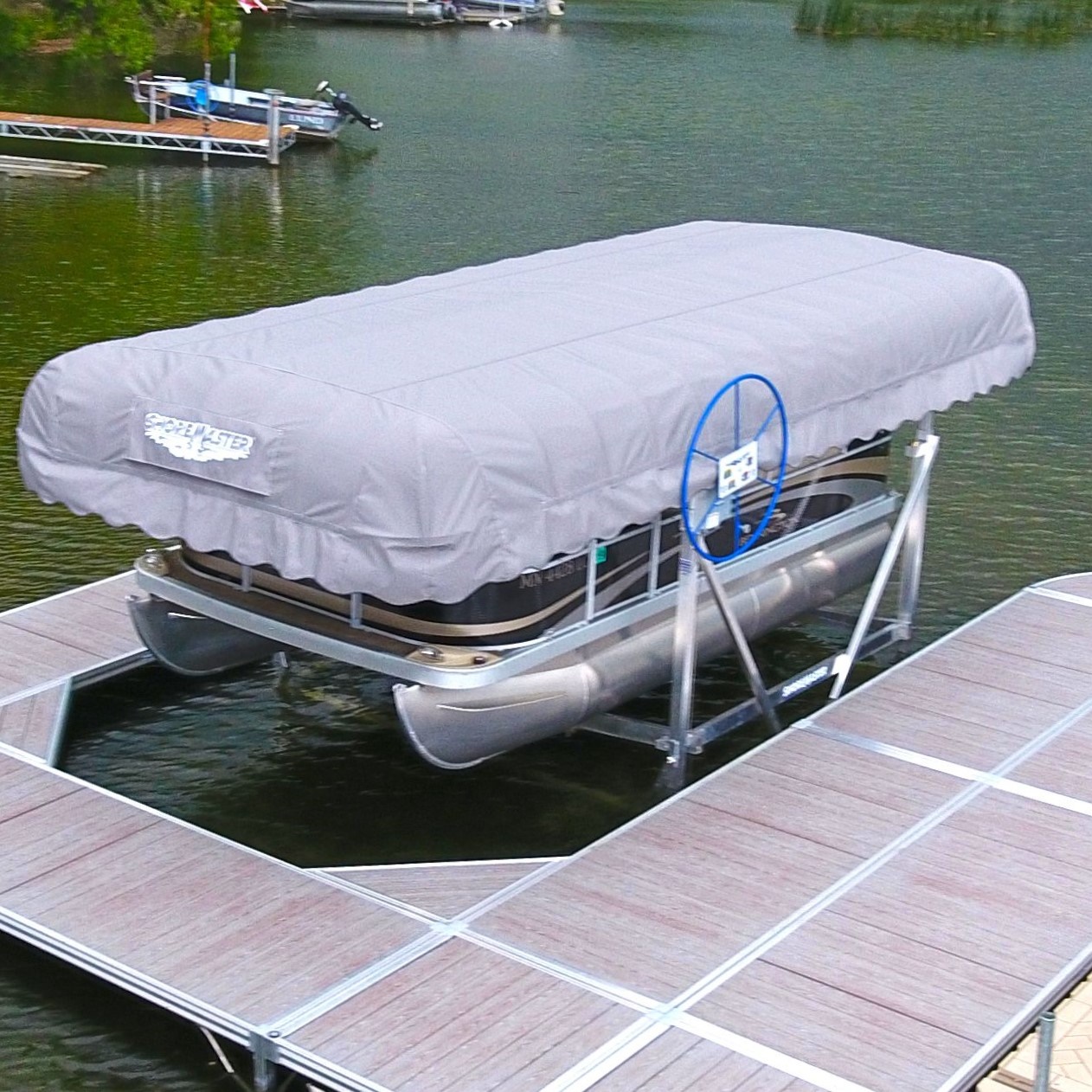
Pontoon Boat Lift
That means don’t head out onto the water when you know a storm is on the way. A pontoon boat is an investment you don’t want to risk for a few more minutes of fun. If inclement weather strikes, head back to the dock and put your boat back on your lift.
Where is Pier & Waterfront Solutions?
Located at 7325 St. Hwy 57, it’s 3 miles south of Sturgeon Bay and 1 mile past the intersection of Cty MM (heading north). Look on the right side, one mile north, at the next corner (Idlewild Road and Hwy 57).
For your protection PWS implemented these preventive measures:
1. Conducting as much business as possible by email, text, or phone.
2. Site visits will continue. When in-person contacts are necessary, we will follow “social distancing” guidelines.
3. Our display yard is always open for you to examine at your leisure. All displays have a numbered, red tag on them. If you want more information or pricing, please reference that number.
Thank you for allowing us to work with you.
YES – PWS is OPEN and waiting for you!
Please call, message, or email PWS with any questions.
Let’s all stay safe!
Sep 7, 2021
SUMMER HAS ENDED
Summer for many people has ended. It’s a sad time for many people. People are heading home. Many families have to get back for school for the kids and can only come back on weekends. Still, there will be some great days left this Fall.
Many of our customers are from out of state. In fact, we have customers from almost ALL the United States. They return each year to enjoy some of our great Wisconsin weather. The size of the crowds will begin going down after Labor Day.
Have no FEAR! Spring is just a couple of months away!
But still, it’s a sad time for many people. Our Chicago and Minnesota customers are among the saddest at this time of the year. Why? They face another year of being defeated by the Packers.
Who else faces problems at this time of the year?
Another group is people with storm-damaged equipment. The Fall storms get stronger in September and October. That’s why we move as fast as we can to get to your location to safeguard your equipment by removing them for the year. The freezing water doesn’t help either.
If you have damage to your equipment please call Jerry @ 920-493-4404.
Not using your docks and lifts anymore this year?
It’s a good idea to drop Keri, our Service Manager, a line letting her know you are ready to be removed. Give her a date when your canopy will be down and your boat stored for the year. Email your message to Keri@wisconsinpws.com. She will put you on the schedule.
It’s particularly tough this year for our crews. One of the dealers in Door County closed expectantly before Memorial Day. Our teams will be working longer hours to adjust to the influx of new customers. As the days get shorter, they will be working by their headlights to meet the schedule.
Four things you should know about fall storms:
- PWS will assist you if a storm damages your equipment. We prepare Free estimates to cover your damage. Insurance companies then use the estimates to prepare a settlement for you.
- We recommend you read this article before talking to the insurance company. Take pictures of all the damage. The more images, the better.
- PWS can also salvage your equipment and make winter repairs, so you are ready to go in Spring.
- PWS will move your equipment to another location if you sold it or bought another property.
PROPERTY DAMAGE?
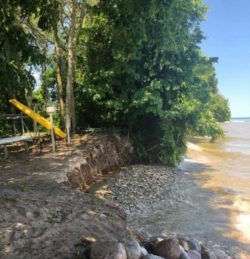
Shoreline Erosion
Do you have property damage, eroded beaches, and lawns? Don’t forget, Pier and Waterfront Solutions has a complete rip rap service available. We’ll have your shoreline repaired for Spring.
Call DAVE at 920-905-2588 for more details.
Where is Pier & Waterfront Solutions?
Located at 7325 St. Hwy 57, it’s 3 miles south of Sturgeon Bay and 1 mile past the intersection of Cty MM (heading north). Look on the right side, one mile north, at the next corner (Idlewild Road and Hwy 57).
Is PWS OPEN?
Pier & Waterfront Solutions remains “open.” We have implemented measures to help ensure the safety of our employees and visitors. PWS continues to work to maintain the trusted service that you have come to expect.
PWS implemented these preventive measures:
1. Conducting as much business as possible by email, text, or phone.
2. Site visits will continue. When in-person contacts are necessary, we will follow “social distancing” guidelines.
3. Our display yard is always open for you to examine at your leisure. All displays have a numbered, red tag on them. If you want more information or pricing, please reference that number.
What can YOU do to help us?
1. Please conduct as much business as possible via emails, messaging, and emails. This step protects everyone involved.
2. When you see our crews installing equipment, please practice “social distancing.” Remain at a safe distance.
Thank you for allowing us to work with you.
YES – PWS is OPEN and waiting for you!
Please call, message, or email PWS with any questions.
Let’s all stay safe!
Aug 31, 2021
DOCK SWAY BRACE
Is a sway brace used on your dock? If not, does your dock sway as you walk on it? There are several reasons this can happen to any dock or pier.
There are main TWO reasons for dock movement.
You need to distinguish between the two types of movement. Is it an up and down movement, or is it a side to side movement?
First, Let’s tackle the Up and Down movement.
When installed, PWS makes sure the legs are firmly on the bottom. This typically makes the dock stable for most people.
Yet, over time, storms can wash out or move the sand or rocks under the footpads. Sand is more susceptible to this action.
It’s the same effect that erosion has on the shoreline. First, it washes away sand and small stones from under the footpad. Then, it continues to work on the remaining stones and rocks. When enough materials are removed, there is nothing left to support the leg.
At this point, you may experience the sensation of up and down movement as you walk.
How do we prevent it from happening?
There is no way to completely prevent washing out of the footpads. If we disturb the lake bottom too much, it weakens the tightly packed base. Disturbing the lake bottom makes it easier for the wave action to wash the sand away. The sand (or small stones) are loosely packed and have small openings in them.
The only “cure” is to reset the legs firmly on the bottom. We notice this frequently occurs after strong storms. The “white caps” you see are moving the water under the surface also.
The second type of movement is actual “sway.”
“Sway” is the side-to-side movement when the dock is set higher above the water.
The current water level is still above average even though it is down from 2019 and 2020. This is evidenced by the continued erosion happening up and down the shoreline.
PWS raises your dock up to protect it from high wave action during the summer. When the frames are adjusted higher, the pier becomes less stable. Walking on the dock will cause a side-to-side movement because the center of gravity is higher.
Think of a simple fishing pole. When the pole moves at the bottom, the movement is amplified at the top of the pole. The higher the frames are raised, the more side movement will occur.
See this link for more information.
There is a solution.
A sway brace on the legs reduces the sway side sway. You’ll feel more secure as you walk the length of your dock.

Sway Brace
Does every set of legs need sway braces?
No. PWS will make recommendations based on the heights and lengths of your dock or pier. Often, we add a single brace on a pair of legs. Next, we alternate the position in the opposite direction on the next set of legs.
One brace is attached near the bottom of one leg and clamped higher up on the opposite leg. This depends on the height of the legs.
It may involve a crew member having to submerge in the water to reach the bottom of the leg. In spring, that is not something anyone wants to do.
Does it matter if I have an aluminum or steel frame?
A steel frame is less likely to need braces than an aluminum frame due to its own weight. Different configurations are available for aluminum frames, but the principle is the same.
Braces are available for new installations, as shown here. There is an add-on version (independent components) for existing frames. They can be added to existing dock legs if needed. Either version will help stabilize your dock in deeper water.
Will sway braces help your dock?
Call Jerry at 920-493-4404 for more details.
Where is Pier & Waterfront Solutions?
Located at 7325 St. Hwy 57, it’s 3 miles south of Sturgeon Bay and 1 mile past the intersection of Cty MM (heading north). Look on the right side, one mile north, at the next corner (Idlewild Road and Hwy 57).
Is PWS OPEN?
Pier & Waterfront Solutions remains “open.” We have implemented measures to help ensure the safety of our employees and visitors. PWS continues to work to maintain the trusted service that you have come to expect.
PWS implemented these preventive measures:
1. Conducting as much business as possible by email, text, or phone.
2. Site visits will continue. When in-person contacts are necessary, we will follow “social distancing” guidelines.
3. Our display yard is always open for you to examine at your leisure. All displays have a numbered, red tag on them. If you want more information or pricing, please reference that number.
What can YOU do to help us?
1. Please conduct as much business as possible via emails, messaging, and emails. This step protects everyone involved.
2. When you see our crews installing equipment, please practice “social distancing.” Remain at a safe distance.
Thank you for allowing us to work with you.
YES – PWS is OPEN and waiting for you!
Please call, message, or email PWS with any questions.
Let’s all stay safe!
Aug 17, 2021
How to Plan an EROSION CONTROL PROJECT
Part 2 of a series discusses FAQ about erosion control – The signs to look for and steps to take. See part one for more information.
Before beginning any actions to correct erosion, determine why the erosion is occurring. Without understanding the problem, any steps taken may waste time and money and may cause or worsen the situation.
Decide if the problem is severe enough to warrant correcting. Is the erosion more than in undisturbed reaches?
What are the threats to private property?
Even though there have been numerous studies and publications on this topic, each problem is unique. There are no manuals with generic plans for bank protection projects which are guaranteed to work.
Although installing a simple erosion control structure yourself may be possible, most techniques have technical standards for size, height, shape, and underlayment. These do not even include the legal requirements of the DNR.
It is best to consult with a resource professional experienced with various techniques when planning the installation of erosion control structures. Thanks to Tip of the Mitt Watershed Council for the use of the above information.
PWS handles all the applications, permits, and drawings from the beginning to the end. PWS does all the work for you. Sit back and relax.
To start the process:
Call Dave @ 920-905-4406 or email dave@wisconsinpws.com.
You can also use this convenient form.
Does controlling the erosion help my property values?
Shoreline erosion creates issues for property owners, aside from hurting the lake environment. Property value is exceptionally dependent on controlling shoreline erosion. “One of the most apparent impacts, and perhaps that most significant concern to many shoreline property owners, is the loss of valuable waterfront property. Given the high value of shoreline property, a loss of just one foot of shore along a 100-foot lot can represent a loss of more than $9,000 on a cost-per-square-foot basis.
These thoughts do not take into account potential damage to, or loss of, near-shore buildings and structures,” according to WatershedCouncil.org.
In recent years, we’ve seen beaches all but disappearing. When property owners try to control shoreline erosion with the wrong methods, they can actually make the problems worse for themselves and their neighbors. That’s why you should leave rip-rap construction up to the professionals at Pier & Waterfront Solutions.
Will my landscaping be destroyed?

Enlarged 36′ x 45′ Barge
PWS can access your shoreline by land. This is the easiest method.
At the same time, we understand the destruction of some landscaping can be a great loss.
PWS has a second method – our 36′ x 45′ barge can do all the work from the lake side. There is no damage to your landscaping.
What can I expect for costs?
The costs vary by what solution is needed. The more complex the solution, the higher the price. A homeowner can expect to spend an estimated $45 – $90* per linear foot on materials. However, if a site is challenging to access, it may cost more.
*Permit fees, design, and installation fees not included. An estimate from PWS includes ALL costs you will encounter. No surprises.
How will I get to the beach with the rip rap in place?
PWS has faced this question numerous times. We install rock steps when requested to make it easy to access the remaining beach, as shown here.

Grouted stairs
In this series of articles, we’ve:
-
- Walked you through some of the leading causes of shoreline erosion:
- What’s happening currently with shoreline erosion and the Great Lakes:
- How to prevent shoreline erosion, and
- What steps you can take to fix it the right way.
Can’t find the answer to your question? Email Dave @ dave@wisconsinpws.com
How does rip-rap work?
Properly installed rip-rap absorbs the energy from the waves as shown in this video. Watch closely at 40 seconds to see the rip-rap doing it’s work. By removing the wave energy, the shoreline stays in tact.
The water drops down into the crevices and dissipates in all directions. See this article for more information.
Where is Pier & Waterfront Solutions?
Located at 7325 St. Hwy 57, it’s 3 miles south of Sturgeon Bay and 1 mile past the intersection of Cty MM (heading north). Look on the right side, one mile north, at the next corner (Idlewild Road and Hwy 57).
Is PWS OPEN?
Pier & Waterfront Solutions remains “open.” We have implemented measures to help ensure the safety of our employees and visitors. PWS continues to work to maintain the trusted service that you have come to expect.
PWS implemented these preventive measures:
1. Conducting as much business as possible by email, text, or phone.
2. Site visits will continue. When in-person contacts are necessary, we will follow “social distancing” guidelines.
3. Our display yard is always open for you to examine at your leisure. All displays have a numbered, red tag on them. If you want more information or pricing, please reference that number.
What can YOU do to help us?
1. Please conduct as much business as possible via emails, messaging, and emails. This step protects everyone involved.
2. When you see our crews installing equipment, please practice “social distancing.” Remain outside at a safe distance.
Thank you for allowing us to work with you.
YES – PWS is OPEN and waiting for you!
Please call, message, or email PWS with any questions.
Let’s all stay safe!















